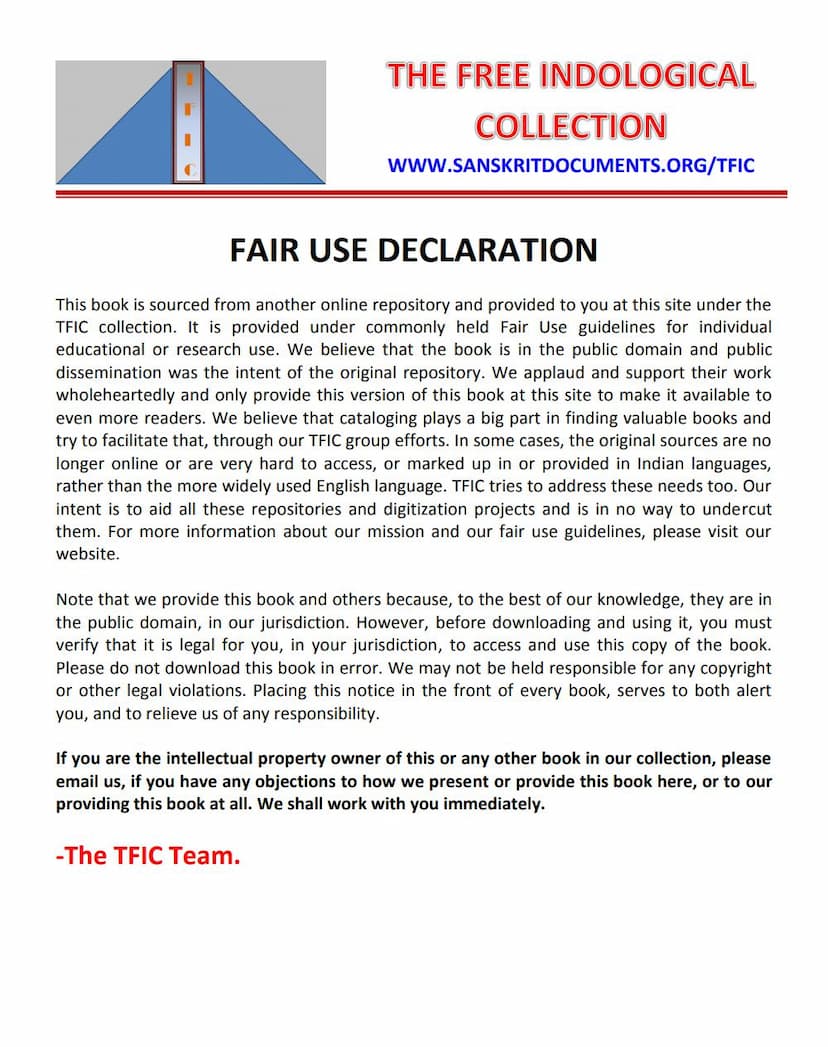Tattvartha Sutra Nikash
Added to library: September 2, 2025

Summary
Here's a comprehensive summary of the Tattvartha Sutra Nikash, based on the provided text:
Book Title: Tattvartha Sutra Nikash Author(s): Rakesh Jain, Nihalchand Jain Publisher: Sakal Digambar Jain Sangh Satna
Overall Theme:
The Tattvartha Sutra Nikash is a commemorative volume, likely a souvenir or collection of articles, published by the Sakal Digambar Jain Sangh Satna. Its primary focus is the Tattvartha Sutra, a foundational Jain scripture, and its interpretation and relevance. However, the book also serves as a record of significant religious and cultural events organized by the Jain community in Satna, particularly during the Chaturmas (monsoon retreat) of Muni Shri Pramansagarji Maharaj in 2004. The book highlights the rich traditions of Jainism, the scholarly depth of its scriptures, and the active community engagement in religious and cultural activities.
Key Sections and Themes:
-
Fair Use Declaration: The initial pages emphasize the book's availability for educational and research purposes, sourced from the "The Free Indological Collection," underscoring a commitment to making knowledge accessible.
-
Visual Depictions: Numerous photographs showcase Jain temples, idols of Tirthankaras (Nemimath, Kunthunath, Ajitnath, Parshvanath, Bahubali), revered Jain saints (Acharya Shri Vidyasagarji Maharaj, Munishri Pramansagarji Maharaj), and prominent Jain figures (Matashri Anantmati). The images also document various community events such as festivals (Nemimath Mahotsav), processions (Nagar Gajarath Yatra), gatherings (Shravak Sanskar Shivir, Jain Yuva Sammelan), religious ceremonies (Mahamastakabhishek), and scholarly events (Sarvodaya Vidwat Sangoshthi). These visuals provide a tangible connection to Jain practices and heritage.
-
Muni Pramansagarji Maharaj's Chaturmas in Satna (2004): A significant portion of the book is dedicated to documenting the events during Muni Pramansagarji's Chaturmas in Satna. This includes:
- Neminath Mahotsav: A grand celebration of Lord Neminath, featuring various religious rituals, cultural programs, and public gatherings.
- Sarvodaya Vidwat Sangoshthi: A national conference of scholars discussing various aspects of Jain philosophy, particularly focusing on the Tattvartha Sutra. This highlights the intellectual and scriptural depth of Jainism.
- Jain Yuva Sammelan: An event aimed at energizing and organizing the Jain youth for community service and spiritual growth.
- Ramyana-Geeta Gyan Varsha: Public discourses by Muni Pramansagarji on these epics, bridging Jain teachings with broader Indian spiritual traditions, attracting large inter-faith audiences.
- Nagar Gajarath Yatra: A spectacular procession described as unprecedented in Satna's history, showcasing devotion and community spirit.
- Pichchika Parivartan Ceremony: A significant ritual for Jain monks.
- Various other events: Including public lectures, cultural programs, and respect for public representatives.
-
Scholarly Articles on Tattvartha Sutra: The book features a comprehensive index of articles that delve into the Tattvartha Sutra from various perspectives:
- The Author and his Work: Articles discussing Muni Pramansagarji Maharaj's personality, his prolific writing, and his scholarly approach to Jain scriptures.
- Historical and Philosophical Context: Pieces on Acharya Umaswami (Griiddhpichha), the author of Tattvartha Sutra, his life, lineage, and the significance of his work.
- Scriptural Analysis: Detailed discussions on the Tattvartha Sutra's structure, its seven Tattvas (principles), the concept of Ratnatraya (Three Jewels - Right Faith, Right Knowledge, Right Conduct), Jain logic (Pramana-Naya Mimansa), and the scientific aspects of Jain philosophy (e.g., regarding Pudgala Dravya, Karma theory, cosmology).
- Modern Relevance: Articles connecting Jain principles to modern science, psychology, law, and environmental protection, demonstrating the timeless applicability of Jain teachings.
- Comparative Studies: Discussions comparing Jain doctrines with other Indian philosophical schools and modern scientific theories.
- Tattvartha Sutra's Commentaries: An extensive section reviewing various renowned commentaries on the Tattvartha Sutra, such as Sarvarthasiddhi by Acharya Pujyapad, Tattvarthavartika by Acharya Akalankadev, and others, highlighting their unique contributions and scholarly merits.
-
Community and Institutional Aspects: The book also touches upon the development and activities of the Digambar Jain community in Satna, detailing the history and evolution of their temple, the establishment of educational institutions (Jain Higher Secondary School), charitable activities (Dayoday Pashu Seva Kendra), and the organizational structure of various Jain societies.
-
Emphasis on Muni Pramansagarji Maharaj's Influence: The text frequently refers to the inspiring presence and guidance of Muni Pramansagarji Maharaj, attributing the success of many events and the intellectual fervor generated by the Sangoshthi to his influence.
Key Jain Principles Discussed:
- Seven Tattvas: The fundamental principles of Jainism.
- Ratnatraya: Right Faith, Right Knowledge, and Right Conduct as the path to liberation.
- Ahimsa: Non-violence as the supreme principle, permeating all aspects of Jain ethics.
- Karma Siddhanta: The theory of karma, its binding process, and its impact on the soul.
- Samvar and Nirjara: Mechanisms for stopping the influx of karma and shedding existing karma, respectively, leading to liberation.
- Samyak Darshan, Samyak Gyan, Samyak Charitra: The core components of the spiritual path.
- Anekanta: The principle of manifold perspectives.
- Sullekhana/Samadhi Maran: The Jain practice of intentional, peaceful death, discussed in relation to legal and ethical frameworks.
- Environmental Protection: Jainism's inherent respect for all living beings and natural elements.
- Social Values: Emphasis on virtues like compassion, truthfulness, non-possession, and social harmony.
Significance:
The Tattvartha Sutra Nikash serves as a valuable resource for understanding:
- The central tenets of Jain philosophy as expounded in the Tattvartha Sutra.
- The historical and cultural context of Jainism in Satna and its surrounding regions.
- The ongoing efforts of the Jain community to preserve and propagate their rich heritage.
- The intellectual discourse and scholarly research undertaken within the Jain tradition.
- The practical application of Jain principles in contemporary life, including social ethics and environmental consciousness.
In essence, this book is a testament to the enduring relevance and multifaceted nature of Jain teachings, presented through the lens of scriptural study and community endeavor.